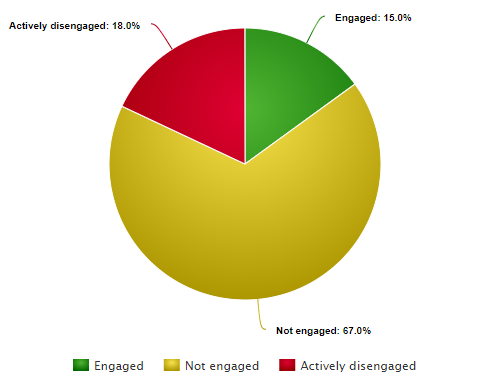Importance of Employee Engagement
Did you know that only 15% of the employees are engaged int their jobs worldwide? According to Gallup’s Global Workplace report, this is the sad truth. But what is employee engagement and why is it important?

What is employee engagement?
There are a lot of different definitions of employee engagement but the main thing is positive connection. Connection to the organisation, to the team or to the task. This can be mental or emotional as well. Just think about it: if you have two different tasks - one that you like and another one that you don’t really like - which one do you prefer? I think the answer is quite simple: the one that you like. If you have positive connection to a job you put more effort to it, you will be more effective and may be finish it faster. And maybe the most important thing is that this kind of job can give you joy and contentment.

Engaged vs. disengaged employees
Employees are the most valuable asset of the organisation, making them engaged is a key for the company’s success.
According to the researchers and company leaders, there are three or four type of employees:
- highly engaged
- moderately engaged
- barely engaged
- actively disengaged.
Highly engaged employees always perform better than others. They are more productive, put extra effort to reach organisational success, motivate others, and they are less likely to leave the company. They know their tasks, and do their best to aim their goals. They feel theirself appreciated, and are aware of their opportunities to develop.

Moderately and barely engaged employees basically do a good job, but they don’t have a strong connection to the company and its mission. Therefor they don’t put extra effort to the tasks, and usually satisfies with an average but not the best solution. Moderately and barely engaged employees can be a great subject to change and development. With a well-built employee engagement strategy the company can turn them into highly engaged employees!
Actively disengaged employees have explicitly negative opinion of their company. They are usually totally disconnected from the organisational mission, goal and their tasks. They don’t feel themself involved and always waiting for the end of working hours. It’s a kind of challenge to make them change their approach and feel commitment - but it’s not impossible.
How to engage employees?
It’s quite a difficult question because we are different. Everybody has different preferences. Probably, the most accepted factor is the desire to have good relationship with others. It’s much better to arrive to a workplace where your mates are waiting for you, not strangers. So one of the engagement tools is helping to improve connection and relationship between the colleagues. Organising common events and provide the possibility of starting conversations. Online tools like Meestory can be very useful for this. For example during a coffee lunch brake common interests and hobbies can turn out. It’s important to not put pressure on the employees, it’s much better if they make new connections and relationships on their own. The HR and teh management can be an assistance but not the pressurer.

The role of the managers and HR
Employee engagement development usually considered as a HR thing. This is partially true: it’s the management’s responsibility as well. HR and management have different perspectives, and both are required to build a successful employee engagement strategy. Sometimes managers also need encouragement and help to gain higher engagement. It’s common that they don’t realize the lack of engagement and other problems or just afraid of changing. In these cases the HR leaders or even the colleagues can share their ideas about the issue or maybe some tools they know or heard of - such as Meestory and others. So the building of the employee engagement strategy is a common task and responsibility of the management and the HR team. And this topic is prominently important during the onboarding process of new colleagues if the company want them stay for a long time.
Conclusion
High level employee engagement is a main advantage of the company. Engaged employees work better, faster. They are motivation to others, and care deeply about their jobs. They are less likely to turn over. The effort put in the employee engagement strategy worth! The company will have efficient collagues and the employees will have a more enjoyable work and a more friendly workplace.


